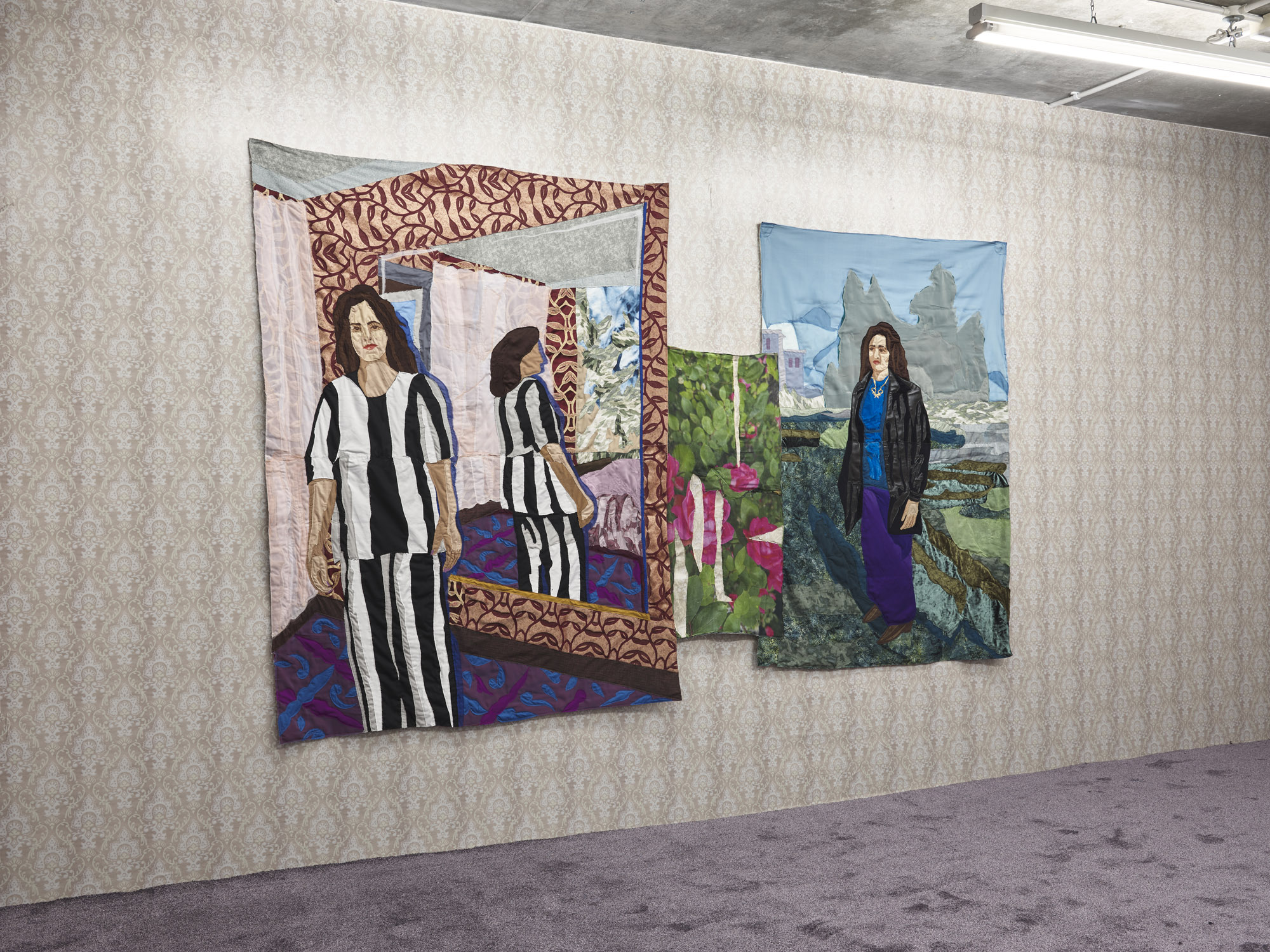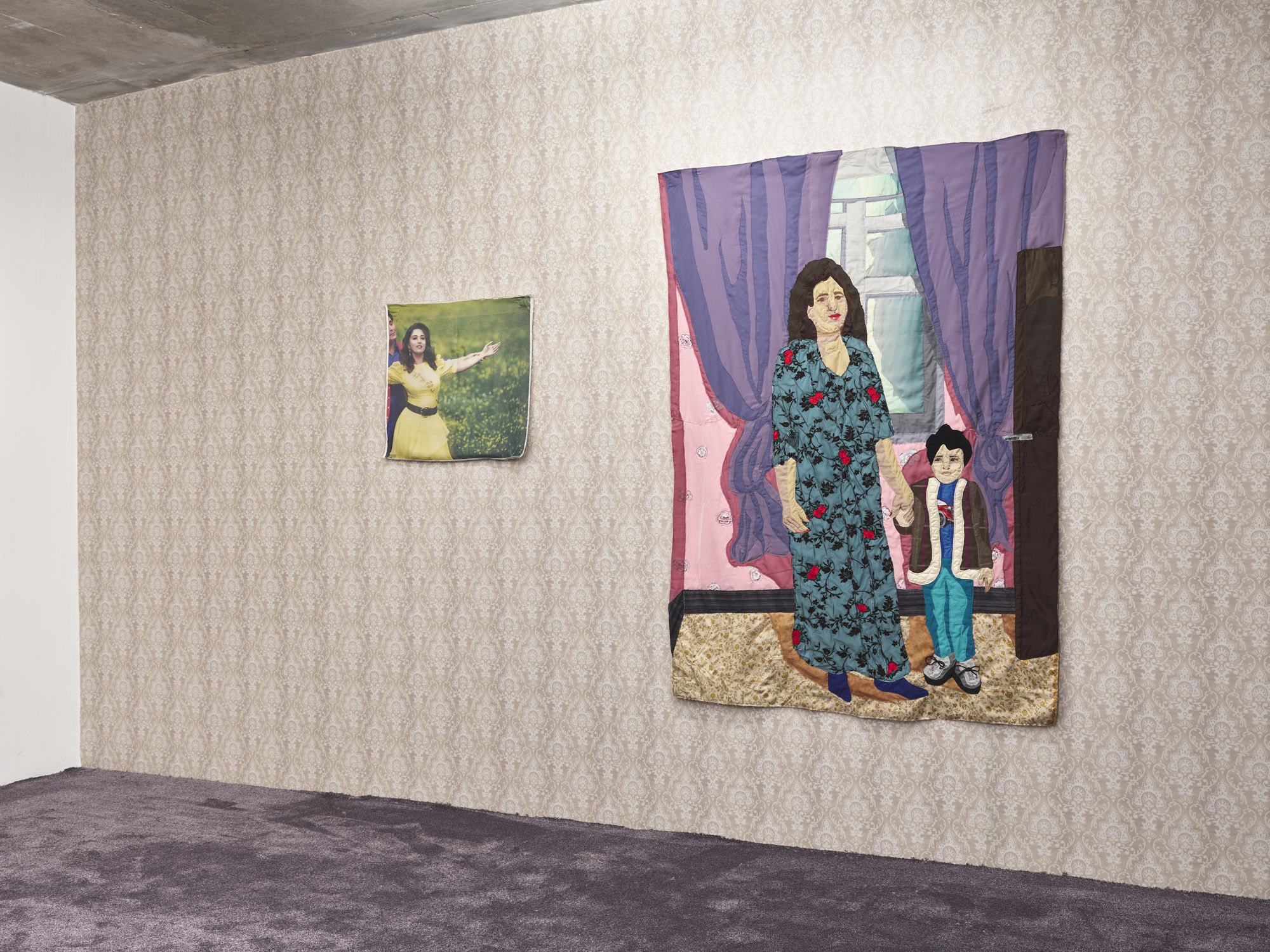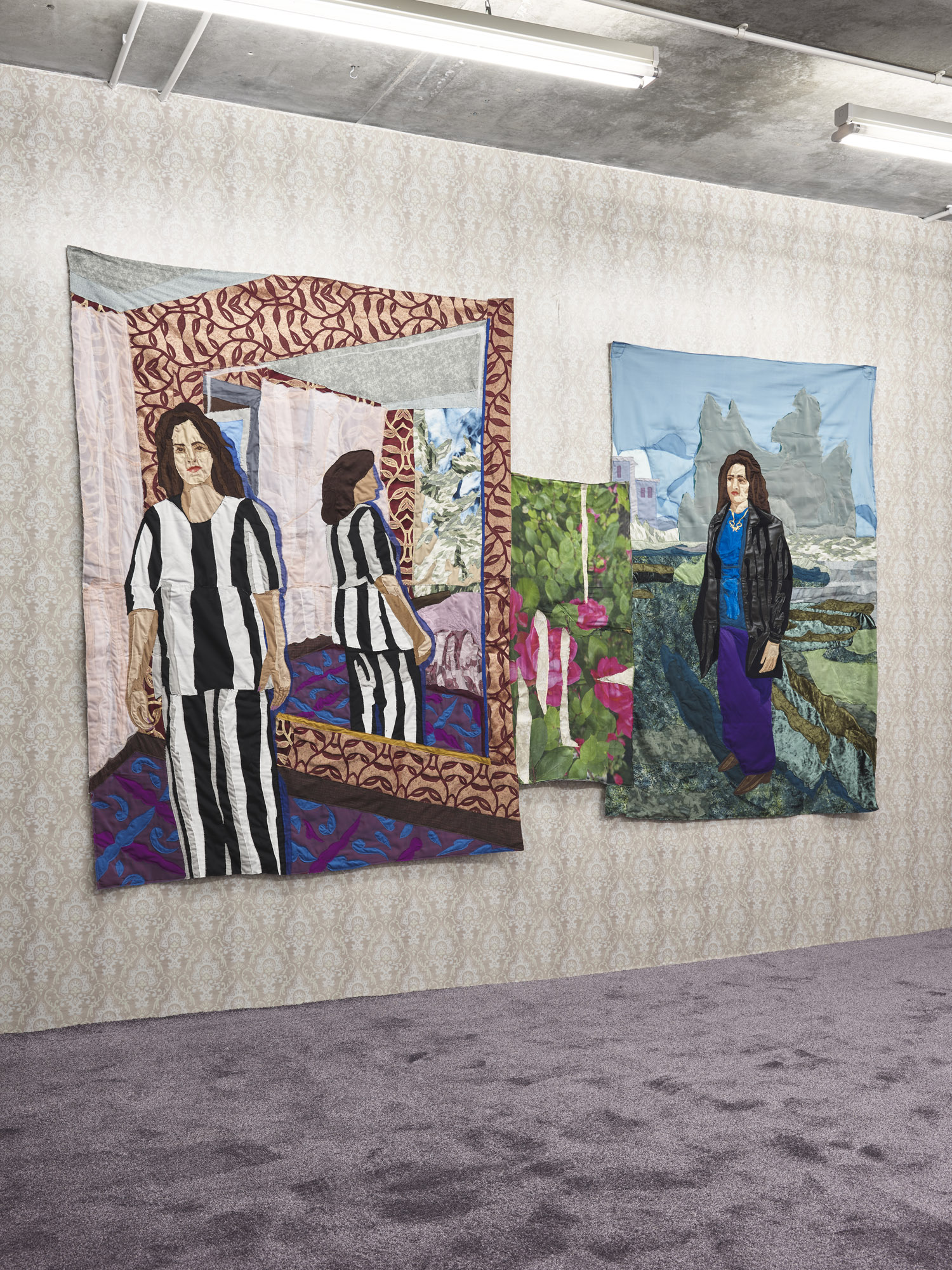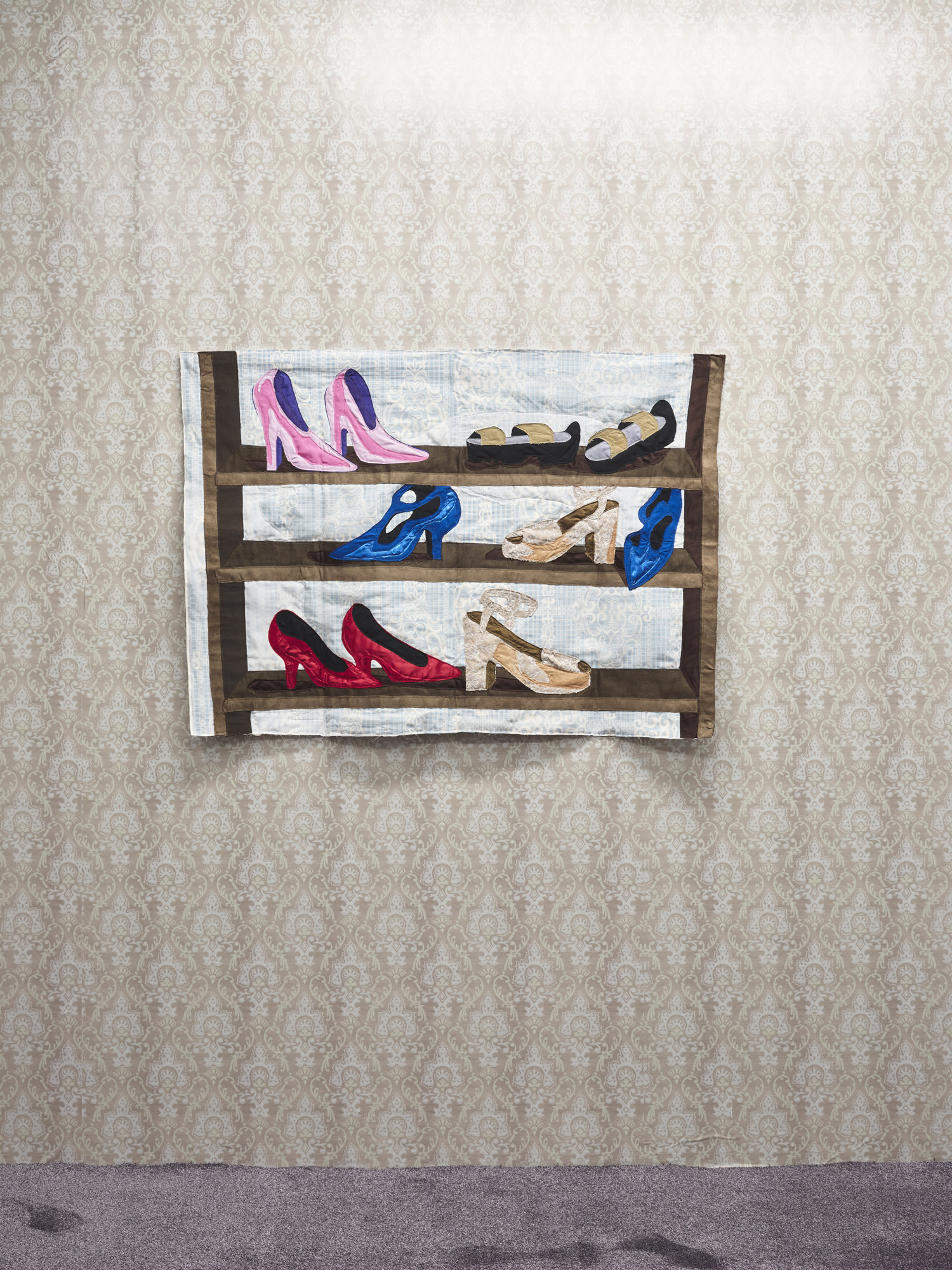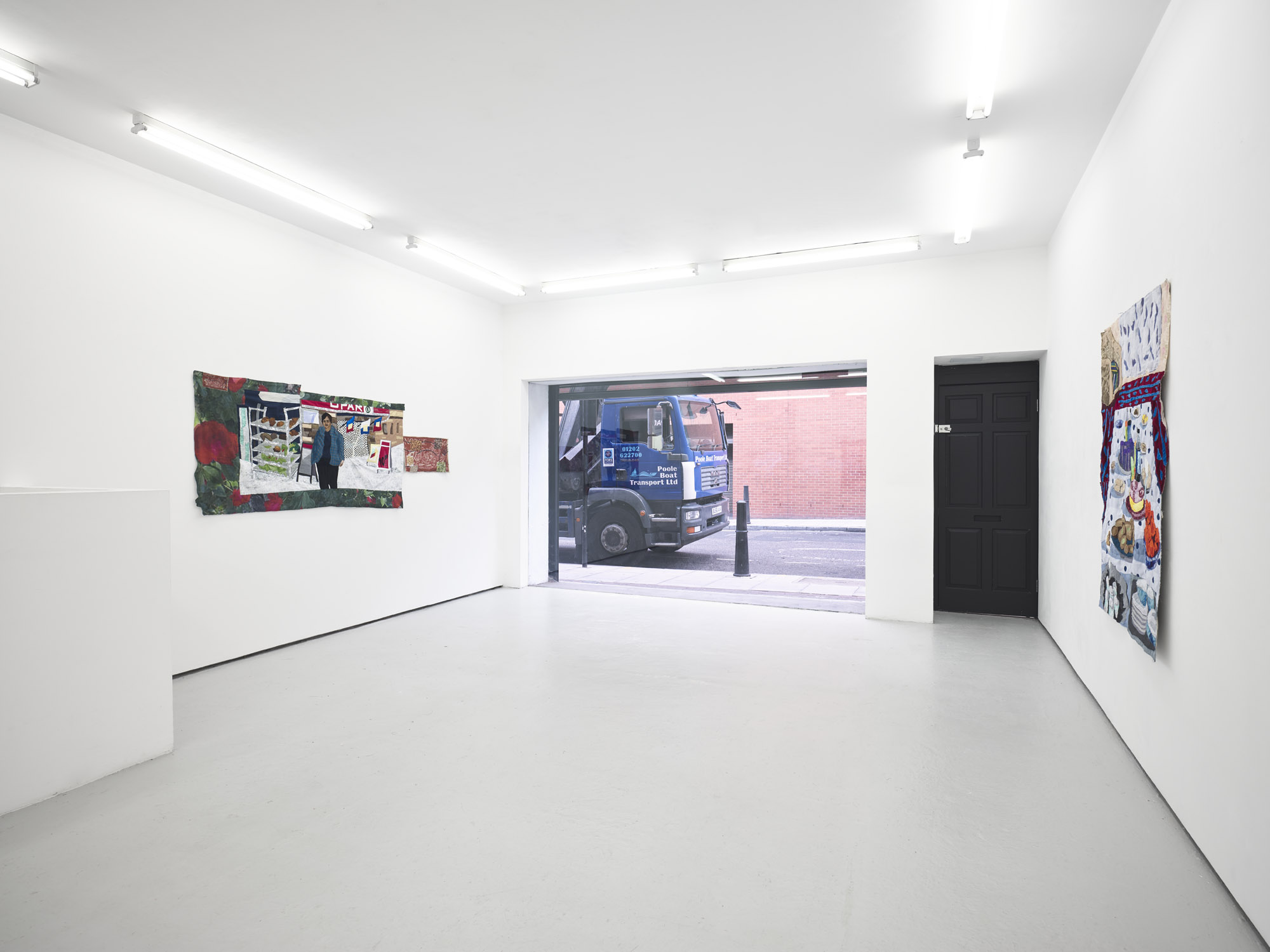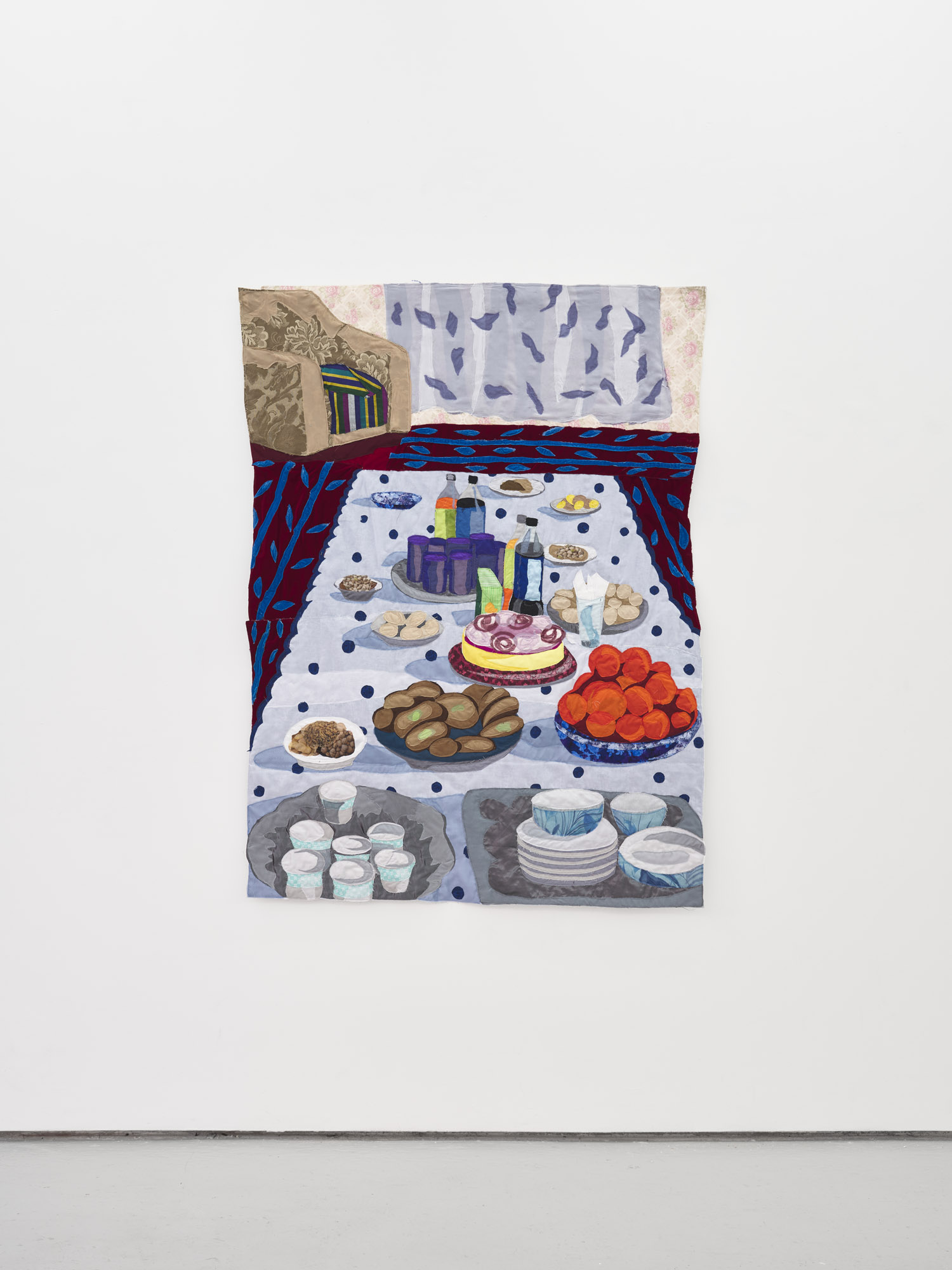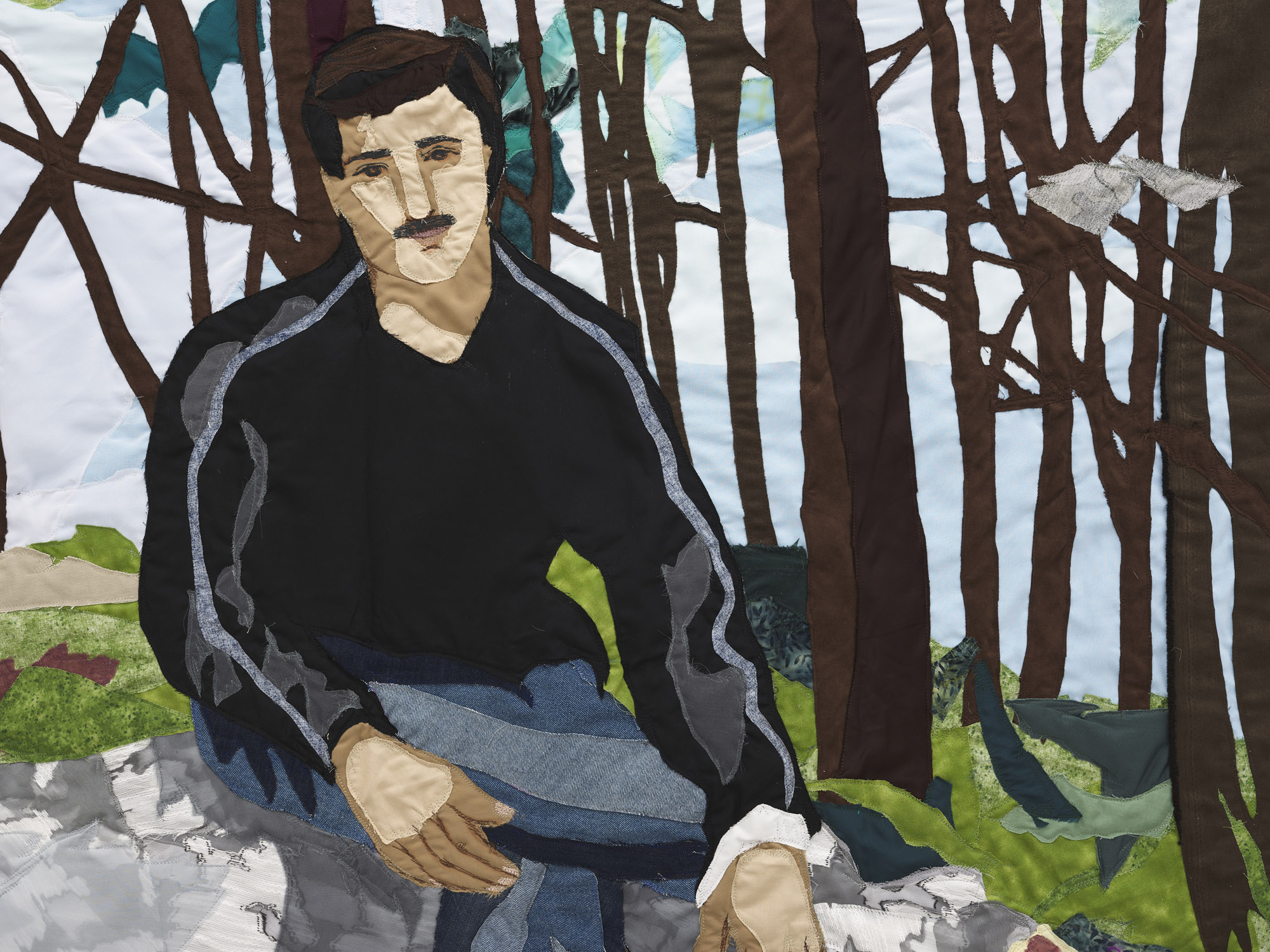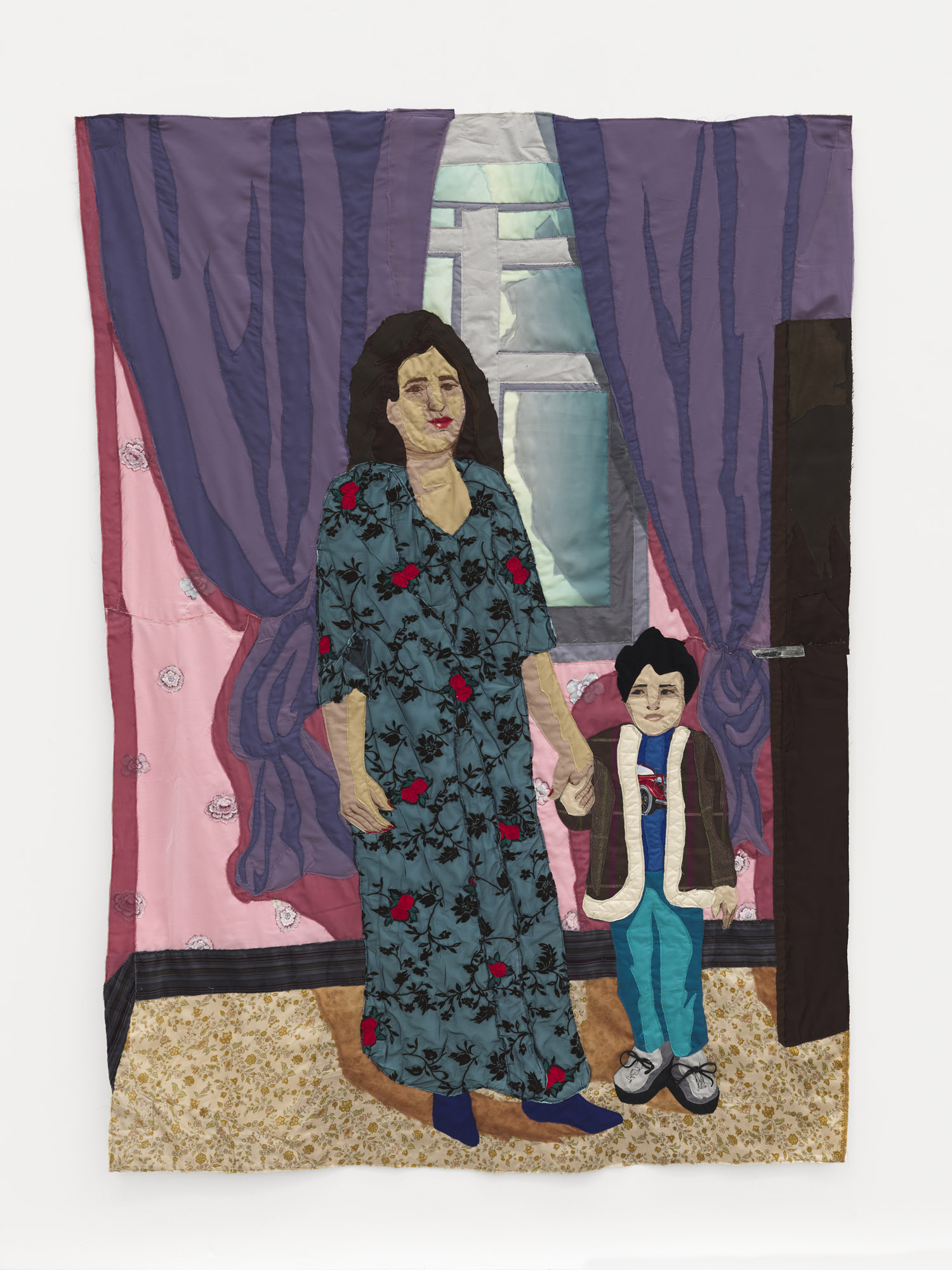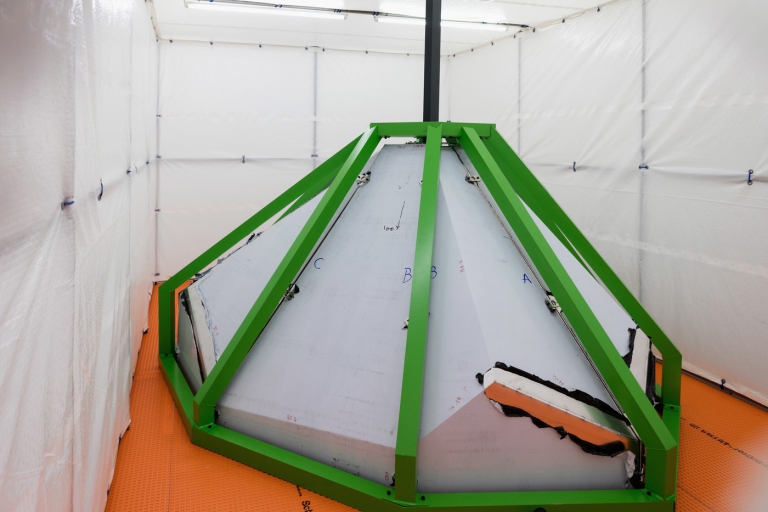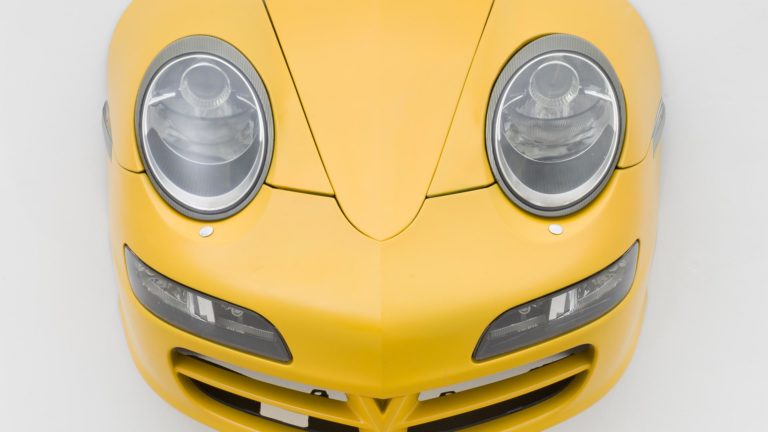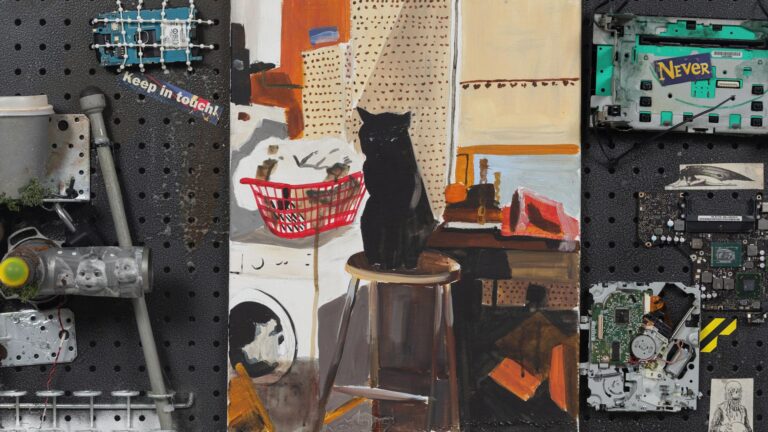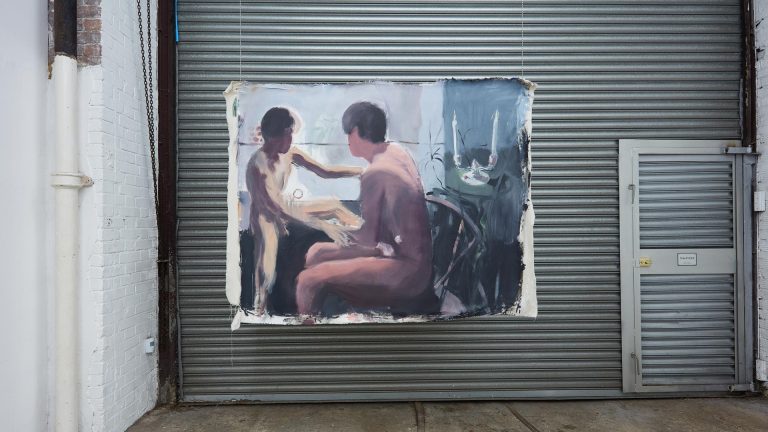Artist: Hangama Amiri
Exhibition title: Reminiscences
Venue: Union Pacific, London, UK
Date: August 25 – September 24, 2022
Photography: all images courtesy of the artist and Union Pacific, London
Hangama Amiri has employed an architectural splitscreen to take us inside the story of a separation. Combining the visual vocabulary of history painting with the skills and materials of a couturier Amiri is reminiscing on her childhood by exploring, in cloth, the photographs her parents exchanged in the years following the family’s exodus from Afghanistan — nine long years during which her father, in an effort to provide for and secure a path to immigration for his family, moved to Norway and then Denmark, while her mother, shuttling between refugee housing, reared Amiri and her three siblings in Tajikistan.
The top floor of the gallery is a repository of her father’s dispatches: plein air self-portraits documenting his life. We see him sitting amongst tulips, in front of a grocery store, about to fell a tree, and resting in a park. Downstairs, we are surrounded by the images her mother shared: self-portraits in which she is always elegantly dressed — she poses alongside a wall of built-in shelves, in a park, with her youngest son, and in front of a mirror. Amiri complicates the cross-cut; a still life of an Eid feast, sent by her mother, is on the first floor and new visuals, imagined by the daughter, appear alongside those of her parents.
Each piece is a kaleidoscopic rhapsody of texture and color. Working in her signature fabric appliqué process, Amiri has expanded her palette for this new body of work through her use of historic wallpaper and bespoke printed textiles. These new materials allow hard-to-find patterns and reproductions of paper ephemera and photographic im-ages into her rich visual lexicon.
Yet, Amiri is not just creating beautiful fabric pastiches of her parents’ photographs. She is fusing archive with memory. Working as a curator she has selected ten images from the multitudes they shared over their long separation, spliced new images amongst their correspondence, and refracted details through her own nostalgia. She intentionally blurs identifying details through her titles. ‘Man with Tulips’ could have been ‘Babaa with Tu-lips’ but Amiri doesn’t directly disclose her relationship to her subjects or name them. In keeping her subjects anonymous she has created space for others to see themselves, to imagine their own narratives, and allowed herself some distance. In her work we are not just looking at a couple, but how a child remembered a couple and how she is looking at them anew though older eyes.
Amiri meditates on the dialogue between her parents’ visuals, in the unspoken declarations each partner was making. Her father’s sun-filled images were a promise to his wife of a better future in peaceful Europe. Her mother’s soignée portraits and abundant still-life, a reassurance that she and the children were safe, joyful, and living well. Amiri celebrates the resilience of her parents’ partnership, yet she is also picking at the ten-sions within their narratives. There were omissions within their pictorial communications that the artist underscores through her selection. Her father, who lived in crowded communal refugee housing, rarely sent home photographs of his living space. Her mother usually posed in their home. In Europe, like many migrants, her father worked for cash at tulip farms. A demanding, labor intensive job that was far removed from his professional life in Afghanistan — a change in identity that was never resented or begrudged; he posed in tulip fields for his family. In splitting her parents’ images across two floors Amiri uses the gallery’s architecture to represent their physical separation, underscoring the distance between their realities and transforming our journey up and down the staircase into a symbolic re-enactment of their emotional labor to stay coupled.
While deeply personal, Amiri’s lush tableaus are also fascinating period pieces speckled with details that capture the extraordinary culture that emerged at the confluence of Afghan and Tajik communities in the late 1990s. She has preserved how families, like hers, celebrated, what entertained them, what their homes looked like, and perhaps most significantly, how they wanted to remember themselves. These lifestyle details, while educational to most, will trans-fix those of us who recognize our childhood in Amiri’s work.
Amiri’s decision to include a photograph of herself and her mother — the only original photograph in the exhibition — is a tongue-in-cheek acknowledgement of the construction of narrative her parents were attempting. Mother and daughter, in matching red shirts, are seated on boulders, amongst flowers and tropical plants while a waterfall roars behind them. It’s a fabricated image, taken at the once ubiquitous neighborhood photo studio. The plants in the foreground are biologically out of place and obviously fake, the hyperbolic waterfall is a studio backdrop. Yet this image, artificially beautified to the point of absurdity, captures the utopic ideation of a generation and how integral photography was to this pursuit, especially for a scattered diaspora.
Interior details break the third wall downstairs. While we walk amongst her mother’s images, the lights have been dimmed, plush carpet cushions our steps, ornate wallpaper clothes the walls and mirrors reflect our own image back to us. It’s a seductive yet jarring sensory experience — soft floors and patterned walls speak to a domestic interior, a private space, not an art gallery. Our wonder and disorientation are faint echoes of the mother’s. She never expected to be standing amongst these walls and floors either — never expected to be a refugee. The homes she poses in were never hers, the government assigned pre-furnished refugee apartments reflected neither her taste or culture. Yet she holds the space — claiming it as her own and celebrating the sanctuary it provides. In enveloping us in this immersive environment and inserting our reflections alongside her mother Amiri slyly prods us to question our positioning: How certain is the safety and security we inhabit? Could we too be refugees one day? How would we bear it?
These are timely questions. Amiri turned to the family archive to process the grief that she, like many young Afghans, has been sitting with of late. Since the Taliban’s return in 2021 she has been in mourning for the countless Afghan families splintered, like hers was, in this recent round of geopolitical roulette. Reminiscing about her extraordinary childhood has been unavoidable as she watches history repeat itself. In shifting her gaze to her parents’ experience and meditating on the ephemera of their nine year separation, Amiri has added depth, nuance and complications to our understanding of contemporary Afghan diaspora, memorialized the resilience and love of an Afghan marriage, and composed a bittersweet ballad of hope for a new generation of separated lovers.
Written by Sarah Burney

















